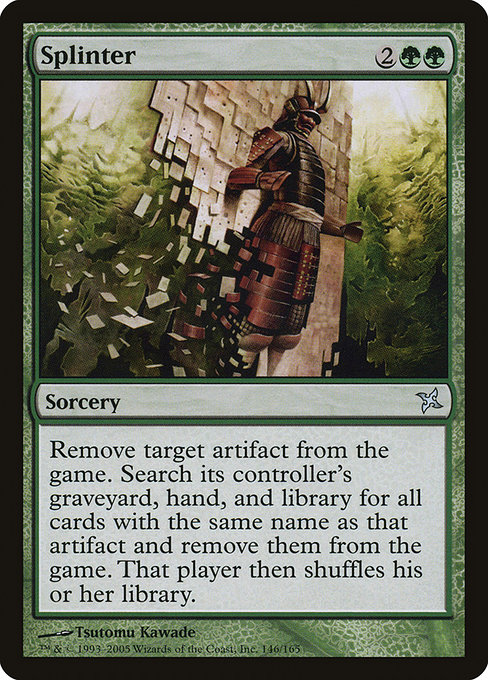
Image courtesy of Scryfall.com
Lessons from Splinter: Silver-Border Rule-Bending in MTG
Splinter, a green sorcery from Betrayers of Kamigawa, asks you to do something quietly audacious: exile an artifact, then root out every copy of that artifact by name from your opponent’s graveyard, hand, and library, before your opponent shuffles. With a mana cost of {2}{G}{G} and an uncommon rarity, Splinter embodies a pragmatic green-playstyle that doesn’t just break a single chain of plays—it fractures the whole supply line of a single artifact’s ubiquity. It’s a clean example of how “rule-bending” in MTG can feel elegant, not gratuitous. The card’s oracle text reads: Exile target artifact. Search its controller's graveyard, hand, and library for all cards with the same name as that artifact and exile them. Then that player shuffles.
What makes Splinter so instructive for discussions about silver-border-style ideas is not just the effect itself, but how it handles the tension between chaos and control. Silver-border sets—think Un-sets and their kin—lean into playful rule interactions that push players to think creatively within, or just beyond, the usual rules, often with a wink. Splinter isn’t a silver-bordered card, but it demonstrates the same spirit: a rule interaction that rewards careful planning, clever targeting, and a willingness to lean into the “what-if” questions that rule-bending conversations love to chase. 🧙♂️🔥💎
How Splinter reframes artifact-centric strategy
Artifacts have always been a backbone of many MTG decks—mana acceleration, value engines, and game-ending combos often hinge on artifact interactions. Splinter folds those archetypes into a narrative about consequence and redundancy. Exiling the target artifact is the first strike; the second strike—removing all other copies with the same name from the opponent’s zones—turns a typical removal spell into a strategic clean-sweep. In formats where artifacts proliferate, Splinter becomes a kind of late-game anti-artifact cure, a reminder that green’s strength is not merely about stomping creatures or growing threat counters but about orchestrating the battlefield’s underlying resources. The card’s green identity and its ability to reach across graveyards and libraries hint at a broader truth: when you disrupt a cornerstone resource, you force your opponent to reassemble their plan from the ground up. ⚔️
From a gameplay perspective, Splinter rewards players who keep a finger on the pulse of their opponent’s architecture. If your opponent has built a deck around a single, name-defined artifact—think of artifact-heavy engines or key combo pieces—Splinter can derail the entire plan in one go. And because the effect also requires you to exile from the opponent's graveyard, hand, and library, you’re not just deleting a piece of the puzzle; you’re erasing potential future plays that could recur via copies or card-draw shuffles. It’s a lesson in tempo and inevitability, a reminder that sometimes the most elegant answers in MTG are not about brute force but about cutting off every possible avenue a strategy might travel. 🧠🪄
Flavor, design, and the art of restraint
The Betrayers of Kamigawa era wrestled with contrasting themes—savvy samurai, neon-lit urban landscapes, and the tactile feel of artifacts woven into mystic rites. Splinter sits at a curious crossroads: it’s a botanical-green spell that targets artifacts, an odd juxtaposition that mirrors the set’s broader tension between nature and man-made curios. The art by Tsutomu Kawade captures a moment of botanical inevitability—the artful, almost ceremonial act of cleansing an artifact’s name from a controller’s toolkit. This juxtaposition—green life seeking to erase manufactured mirrors of power—feels at once old-school MTG and modern in its meta-awareness. The card’s color identity and its effect demonstrate how design can honor a deck’s core philosophy (artifact disruption) while still delivering a flavorful, memorable moment on the battlefield. 🎨🧙♂️
In the larger arc of MTG design, Splinter’s dual-action approach—targeted removal plus a name-based sweep—invites players to think about how naming and identity matter in card games. It’s a tiny primer on the complexity hidden inside simple lines of text: name-based interactions are rare, but when they occur, they can unlock surprisingly deep strategic avenues. For collectors and flavor enthusiasts alike, Splinter is a reminder that even green cards can carry the weight of artifact culture and the thrill of strategic disruption. 🧩
Beyond the battlefield: value, lore, and the modern play environment
Splinter’s rarity is uncommon, and its foil-print economics reflect the value some players place on situational—but potent—green answers. The card’s price on Scryfall hints at modest, but not negligible, utility, with foils commanding premium for decks that can reliably leverage its sweeping effect. From a lore standpoint, Splinter doesn’t need a grand legend to justify its presence; it exists because MTG often thrives on the unexpected consequences that arise when you pry a single artifact free from its name’s gravitational pull. In a modern play environment where artifact-heavy decks still appear, Splinter remains a useful reference point for the power of well-timed exile and the strategic value of name-based interactions. ⚡💎
As a cultural touchstone for MTG fans, Splinter embodies a core truth about silver-border-inspired thinking: the most memorable moves aren’t always the loudest. They’re the ones that reveal a cunning understanding of consequences, resource management, and the delicate balance between disruption and opportunity. Whether you’re drafting in Modern or exploring the nostalgic corners of legacy, Splinter offers a compact lesson in how to bend the frame of a game without breaking its rules entirely. 🧙♂️🎲
Clear Silicone Phone Case: Slim, Durable Open-Port DesignMore from our network
- https://crypto-acolytes.xyz/blog/post/evolution-of-crypto-casinos-blockchain-bets-and-beyond/
- https://blog.zero-static.xyz/blog/post/grading-mutagen-connoisseur-authenticity-tips-for-mtg-collectors/
- https://crypto-acolytes.xyz/blog/post/arcade-hacking-scandals-what-the-high-scores-hide/
- https://blog.digital-vault.xyz/blog/post/create-eye-catching-poster-templates-for-motivational-quotes/
- https://blog.digital-vault.xyz/blog/post/flavor-meets-function-ring-of-gix-artifact-mechanics-explained/